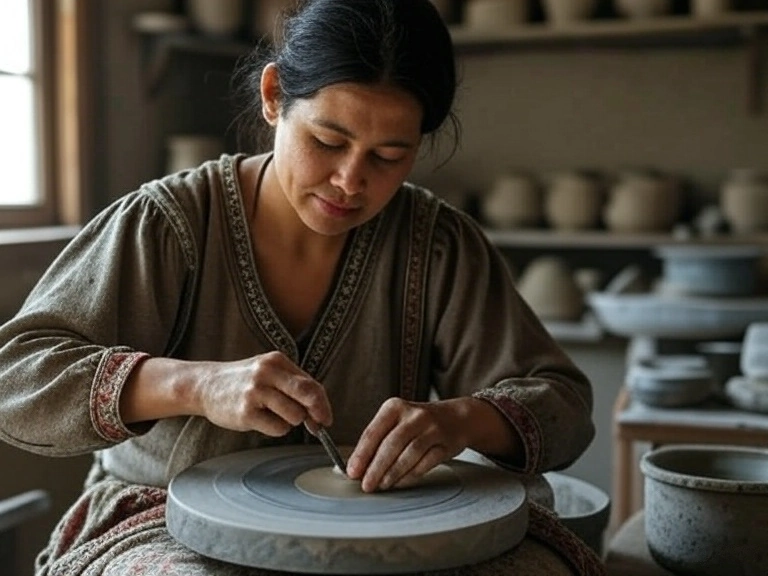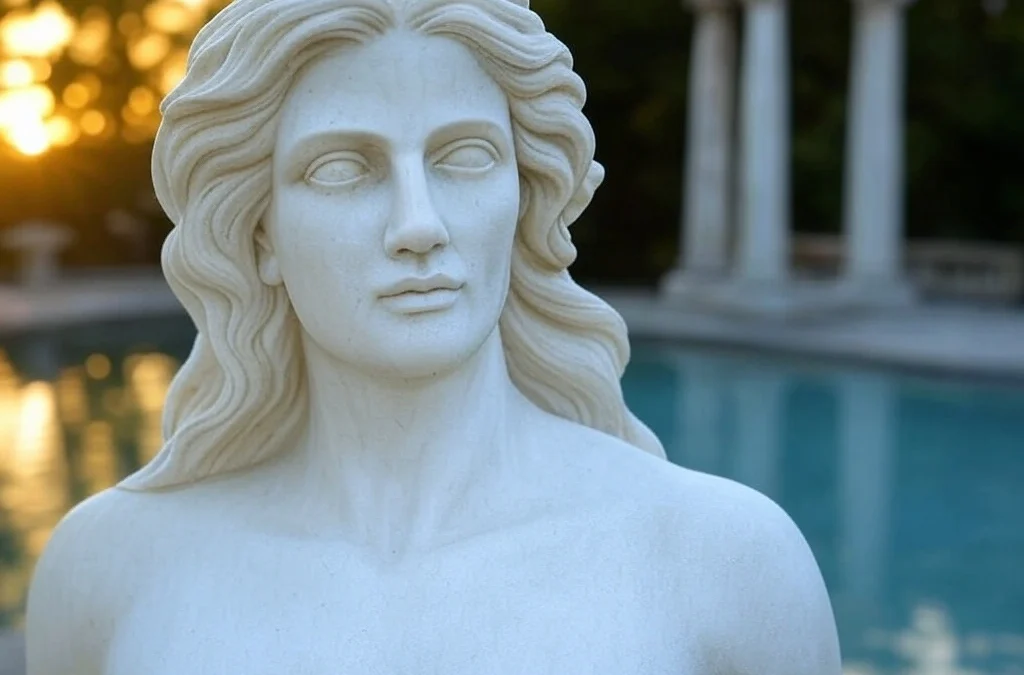In Greek mythology, Hermaphroditus was born as the son of Hermes, the messenger god, and Aphrodite, the goddess of love and beauty. His name combines those of his parents—Hermes and Aphrodite. As the child of two Olympian deities, Hermaphroditus was extraordinarily beautiful, inheriting the best features from both parents.
According to ancient myths, the nymphs of Mount Ida in Phrygia (modern-day Turkey) raised Hermaphroditus. He grew up to become an incredibly handsome young man who caught the attention of many. His striking beauty made him hard to resist, but his story took an unexpected turn when he reached his teens.
The Transformation at Salmacis
The most famous myth about Hermaphroditus centers around his encounter with the water nymph Salmacis. While traveling through Caria in Asia Minor (modern southwestern Turkey), Hermaphroditus came upon a clear, inviting pool of water. This pool was the home of Salmacis, a nymph who fell instantly in love with the young god when she saw him.
When Hermaphroditus stopped to bathe in her waters, Salmacis hid among the reeds, watching him. Captivated by his beauty, she eventually rushed out and embraced him. Despite his resistance, she refused to let go and prayed to the gods that they would never be separated.
The gods granted her wish, but not in the way she expected. Salmacis and Hermaphroditus merged into a single body with both male and female physical traits. This new being retained the name Hermaphroditus and possessed the characteristics of both sexes.
What is Hermaphroditus the God of?
Hermaphroditus is known as the god of intersexuality, androgyny, and the union of male and female qualities. Unlike most Greek deities, who had strict roles tied to war, wisdom, or love, Hermaphroditus stood for the blending of opposites. He symbolized balance between masculine and feminine traits and challenged the idea that identity must fit into a simple category.
In ancient Greek religion, Hermaphroditus became a symbol of completeness. His story reflected the belief that true harmony comes from combining different forces rather than keeping them apart. Some scholars also connect Hermaphroditus to fertility, viewing his dual nature as a metaphor for creation and the joining of male and female in marriage.
Because of this, Hermaphroditus held a unique place in the Greek pantheon. He was not tied to power or conquest but to unity, transformation, and the deeper bonds that exist between seemingly opposite traits.
Hermaphroditus in Ancient Worship
Though not as widely worshiped as the major Olympian gods, Hermaphroditus had dedicated followers throughout the ancient Mediterranean. In Athens, there was a tradition of placing flower garlands on statues of Hermaphroditus during certain festivals.
Some ancient cities, particularly in Asia Minor, celebrated Hermaphroditus in religious ceremonies that honored gender fluidity and the blending of male and female energies. These rituals often involved both men and women participating equally—unusual for many ancient religious practices that separated genders.
Who Did Hermaphroditus Love?
The myths don’t provide much information about Hermaphroditus’s romantic relationships before or after his transformation. The most significant relationship in his story is with Salmacis, though this was not initially reciprocated. Hermaphroditus was not seeking her love when she embraced him at the pool.
After becoming dual-natured, ancient texts don’t specifically mention Hermaphroditus falling in love with anyone. Unlike many Greek gods known for their numerous affairs, Hermaphroditus seems to stand apart from these typical divine romantic entanglements. His story centers more on identity transformation than romantic pursuits.
Sources Behind the Story of Hermaphroditus
The story of Hermaphroditus comes directly from ancient literary and artistic sources. These works help historians and scholars piece together how the Greeks and Romans understood this figure and his meaning.
One of the earliest and most important sources is Ovid’s “Metamorphoses“, written around 8 AD. In Book IV of this epic poem, Ovid tells the story of Hermaphroditus and Salmacis in vivid detail. His version explains how the young god was merged with the nymph, creating a being with both male and female traits. “Metamorphoses” has been one of the main references for understanding the myth ever since.
Ancient Greek art also gives important clues. Statues and reliefs from the Hellenistic period often depict Hermaphroditus, showing a blend of masculine and feminine forms. A famous Roman marble sculpture known as the “Sleeping Hermaphroditus,” now at the Louvre Museum in Paris, reflects how artists portrayed this unique figure based on earlier Greek models.
Writings by ancient philosophers like Aristotle also touch on the broader idea of natural variations. In works such as “Generation of Animals,” Aristotle discussed how nature could sometimes produce forms that mixed male and female characteristics, even though he did not name Hermaphroditus directly.
Other sources include mentions in ancient Greek vase paintings and inscriptions from shrines dedicated to lesser-known deities blending male and female traits. These artifacts show that while Hermaphroditus was not one of the major Olympian gods, his story and symbolism had a lasting cultural presence.
Modern scholars, including classicists and historians of ancient religion, rely heavily on these ancient texts, artworks, and archaeological findings to interpret the myth today. By putting these sources together, it becomes clear that Hermaphroditus was an important figure for thinking about identity, beauty, and the blending of opposites in ancient times.
Was Hermaphroditus Intersex?
By modern definitions, yes, Hermaphroditus would be considered intersex after his transformation. The ancient myth specifically describes him as having both male and female physical characteristics following his merger with Salmacis. Before this event, he was depicted as male.
It’s important to note that ancient Greek understanding of sex and gender differed from modern concepts. The myth of Hermaphroditus explores the concept of dual nature rather than addressing the nuanced understanding of intersex conditions we have today. Nevertheless, Hermaphroditus represents one of the earliest mythological examples of a figure who embodied both male and female physical traits.
Cultural Impact and Legacy
The term “hermaphrodite” derives directly from this mythological figure, though modern medical terminology favors “intersex” to describe people born with variations in sex characteristics. Throughout history, artists have depicted Hermaphroditus in sculptures, paintings, and literature, often emphasizing the beauty and mystery of his dual nature.
In ancient Rome, wealthy homes sometimes featured sculptures of Hermaphroditus as artistic decorations. These works celebrated the aesthetic beauty of combined male and female forms rather than having explicit religious significance.
Later European art continued to find inspiration in Hermaphroditus, with Renaissance artists creating numerous works based on the sleeping Hermaphroditus motif. The Louvre Museum in Paris houses a famous Roman copy of a Hellenistic sculpture showing Hermaphroditus asleep on a mattress.
How Ancient Greeks Viewed Hermaphroditus
In ancient Greece, physical perfection was highly valued. Beauty was often seen as a sign of divine favor. Hermaphroditus, with his combination of male and female features, challenged the usual standards of beauty. Yet he was admired rather than rejected.
Ancient texts show that Hermaphroditus was not treated like a monster or an outsider. Instead, he was respected. Artists sculpted statues of him. Poets told his story. People in cities like Athens and Ephesus left offerings at his shrines, hoping to gain blessings of unity and balance.
This acceptance shows something important about the ancient mindset. While Greek society had strict roles for men and women, it could still find room for figures who did not fit the mold. Hermaphroditus stood as proof that different traits could exist together. The idea of combining opposites into something whole was powerful.
In everyday life, many Greeks would have seen symbols of Hermaphroditus during festivals and public ceremonies. These images reminded them that beauty and identity could be more complex than simple categories. It is easy to imagine a young Greek artist or a philosopher stopping at a shrine of Hermaphroditus, wondering what it meant to be fully human.
Today, Hermaphroditus remains a figure that challenges easy definitions. His myth reminds us that the questions of identity, balance, and acceptance are not new. They have been part of human experience for thousands of years.
Understanding the Myth in Context
The story of Hermaphroditus reflects ancient Greek attempts to explain natural diversity and the spectrum of human experience. Unlike some other Greek myths that served as cautionary tales, the transformation of Hermaphroditus wasn’t presented as a punishment but rather as a different state of being.
Some historians suggest that the myth helped ancient Greeks process the existence of intersex individuals in their society. By attributing such conditions to divine intervention, they created a framework for understanding variations that didn’t fit neatly into binary categories.
Artistic Depictions of Hermaphroditus
Hermaphroditus became a popular subject in ancient art. Sculptors, painters, and poets were fascinated by his unique form. His image combined the strong body of a young man with the softer features of a woman. This blend challenged traditional ideas of beauty but also offered something new to admire.
The famous “Sleeping Hermaphroditus” sculpture, now housed in the Louvre Museum, shows this clearly. From one side, the figure looks like a beautiful woman resting. Walk around it, and the masculine features become visible. The experience surprises many visitors. It makes them stop and think about what beauty really means.
In ancient Roman homes, it was common to find statues of Hermaphroditus in gardens and courtyards. These were not just decorations. They were reminders that the world is full of mysteries that don’t always fit simple explanations. In a time when gods and myths were part of everyday life, Hermaphroditus represented a natural wonder that deserved respect.
Art historians believe that Hermaphroditus symbolized more than just physical form. He showed the human longing for completeness. Many people still feel that pull today—the desire to find balance between different sides of themselves. Looking at ancient sculptures of Hermaphroditus can feel strangely familiar, even across thousands of years.
The art connected to Hermaphroditus proves how deeply his myth influenced ancient culture. It also shows how lasting that impact has been. In museums, books, and private collections, Hermaphroditus still captures human imagination. His story and image remind us that identity and beauty are not always what they first seem.
Hermaphroditus in Modern Interpretation
Today, scholars view the myth of Hermaphroditus through various lenses. Gender studies experts see it as an early example of literature exploring gender fluidity. Others interpret it as representing the ancient Greek idealization of completeness – the joining of male and female into a whole being.
The story continues to resonate in discussions about gender, identity, and the limitations of binary thinking. While ancient Greeks lacked our modern vocabulary for discussing these concepts, the myth of Hermaphroditus shows that humans have long been aware of and fascinated by the complexity of gender and physical sex
Read also:
Hermaphrodite: 20 Human Examples & Meaning
Discover 20 real-world human hermaphrodite examples and the meaning of this term. Explore how hermaphrodites exist in real life today!
Symbolism of Hermaphroditus in Ancient Thought
The story of Hermaphroditus carried deeper meaning beyond the surface of mythology. To the ancient Greeks, he stood as a symbol of balance. He showed that strength and beauty were not confined to one form. They could be found together, even when they challenged ordinary expectations.
Philosophers in ancient Greece often spoke about the idea of unity. Plato, for instance, described a time when humans were both male and female before the gods split them apart. Although Hermaphroditus’s myth is separate, it reflects a similar longing. The image of one being combining two natures connected deeply with human hopes about completeness.
In daily life, Greeks understood that opposites often belonged together. Night and day. Land and sea. Masculine and feminine. Hermaphroditus captured this thinking in a single figure. He became a reminder that the world was not simple, but layered and rich.
Ordinary people visiting a shrine or attending a festival may have seen Hermaphroditus differently than poets and philosophers. They might have thought about their own families, marriages, or communities. They might have seen him as a sign that differences could live side by side without destroying each other.
The myth of Hermaphroditus encourages questions that still matter today. What does it mean to be complete? Can strength and gentleness exist in one person? These ideas are not just old thoughts from a lost world. They are part of what it means to be human.
Hermaphroditism in Ancient Greece
In ancient Greece, hermaphroditism was not fully understood in a medical sense. However, it was recognized as part of the natural world. Stories like that of Hermaphroditus show that the Greeks saw physical and gender differences as something worth explaining through myth rather than hiding away.
Hermaphroditic figures in Greek art and literature were sometimes treated with fascination and even respect. They were viewed as special, not necessarily cursed. In some cases, people believed that beings with both male and female traits carried divine significance. Their existence pointed to the idea that nature could combine opposites to create something rare and powerful.
That being said, Greek society still had clear expectations for men and women. Daily life was often divided by gender roles. A person born with ambiguous traits might have faced confusion or curiosity rather than outright acceptance. There were no legal protections or formal categories like there are today. Instead, myths like Hermaphroditus helped the Greeks process what they saw in the world around them.
Ancient philosophers sometimes mentioned hermaphroditism when discussing nature’s unpredictability. Aristotle, for example, wrote about variations in birth and how nature did not always follow simple patterns. These writings show that Greek thinkers were aware of exceptions to the usual categories of male and female.
From a religious perspective, figures that blended male and female qualities could be linked to fertility, creation, and mystery. Temples, statues, and festival rituals sometimes featured such imagery, though these examples were rare compared to the dominant male or female depictions of gods.
For the average Greek citizen, encountering a hermaphroditic figure—whether in myth, art, or possibly in life—likely provoked mixed feelings. Awe, confusion, respect, and curiosity all played a part. In a culture that celebrated both logic and mystery, Hermaphroditus and the idea of hermaphroditism found a place, even if it was not fully understood.
The Most Popular on BitGlint

Top 100 Personal Items List
Everyone uses personal items in their daily lives, often without even thinking about them. From the moment you wake up...

30 Defiance Examples & Meaning
Defiance is something most people experience at some point in life. You feel it when you say no to something that...

Top 30 Desire Examples & Definition
Desire is a powerful force that drives much of human behavior, shaping our goals, dreams, and everyday decisions. It's...

100 Non-Digital Things List
In everyday life, there are still hundreds of objects, tools, and materials that exist completely outside the digital...

30 Examples of Attention & Definition
Have you ever noticed how a catchy tune can grab your attention, even when you're busy doing something else? It's...

60 Cultural Traditions Examples & Definition
Cultural traditions are part of daily life - whether people realize it or not. They shape what we eat, how we...

Top 30 Intimacy Examples & Meaning
Intimacy goes beyond physical touch or romantic moments. It’s about closeness, trust, and connection. In everyday...
Get Inspired with BitGlint
The Latest
40 Emotional Value Examples & Meaning
Why do some messages stick — while others are forgotten? Why do people choose one brand over another, even when the product is the same? The answer often comes down to emotional value. Emotional value is what makes a message feel human. It’s the emotional connection...

30 Teasing Examples & Definition
Teasing is a common part of human interaction. People tease in different ways, for different reasons. Sometimes it is friendly. Sometimes it can hurt feelings. Understanding what teasing means and seeing clear examples helps everyone handle these moments better....
40 Thought Experiments for Curious Minds
Some questions can’t be answered with a simple yes or no. Some problems don’t have a clear solution. That’s where thought experiments come in. They aren’t just old ideas from philosophy books. Thought experiments are tools we still use to think through problems, test...
30 Focus Examples & How to Improve Concentration
Focus is one of the most important skills in life. Whether you're working, studying, playing sports, or even having a conversation, your ability to stay focused can determine your success. But many people struggle with distractions, short attention spans, and mental...


